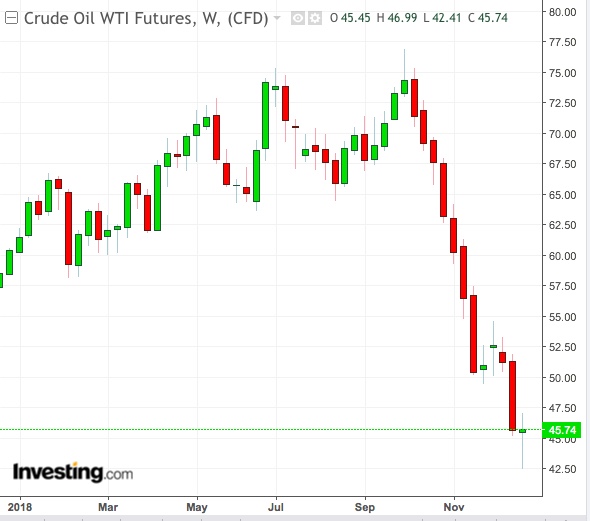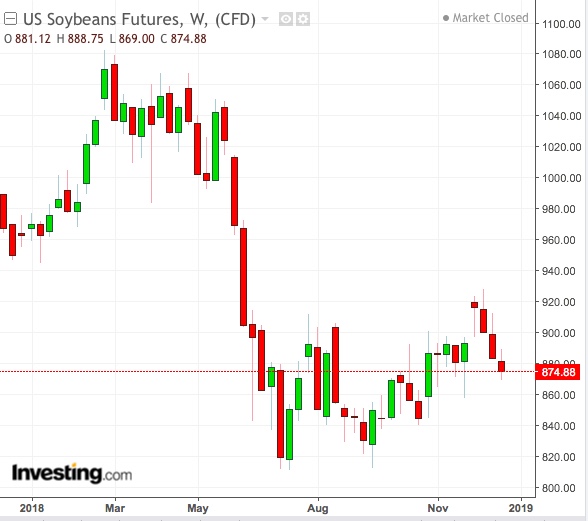From a tweeting president to a murdered journalist, commodity prices were influenced by everything from odd politics to the truly macabre in 2018. From oil to orange juice prices, the surprising catalysts kept coming, with more likely till the closing bell on December 31.
Dominick Chirichella of New York’s Energy Management Institute, who’s witnessed almost all there is to be seen in the oil market over the past four decades, couldn’t have said it better when he wrote, a week ago, in his final analysis for the year that “the end of 2018 could not be more different than the end of 2017”.
Just the sheer divergence in the performance of commodities over the past two years would be adequate to support that thesis.
Big Oil And Metals Losses, Huge Gas Swings
In 2017, US crude ended up 13 percent, with the biggest daily move no more than 3 percent, despite the market retrenching from the first ever shale-engineered oil oversupply. This year, with a less pronounced, shale glut '2.0', the market is looking at a 40 percent loss after overseeing the worst bearish streak in history: an uninterrupted 12-day selloff.
But oil’s volatility into the year-end has just been as intense, with 7-percent down days versus 9-percent up days that could keep traders in suspense till the final session.

Speaking of volatility, nothing could compare to this year's 18 percent move for natural gas during a single day—three times more than its 2017 peak. The gyrations deprived gas of the commodities performance crown for 2018, pushing it to third place behind cocoa and wheat as of this writing, despite low winter reserves for the fuel. Annual gains, which stood as high as 60 percent a month ago, have fallen to just around 16 percent.
The story in metals is just as extraordinary. In a rare phenomenon, the futures of nearly every traded base metal in London and New York are set to finish the year with double-digit losses despite top commodities buyer China putting on hold its tariffs battle with the United States, amid expectations of an imminent deal between the two economic superpowers. Copper, which heads the global metals complex, is down 17 percent while zinc and lead both saw losses in excess of 20 percent.
On the agricultural front, soybeans are also nearing double-digit losses, defying optimism springing from the same US-Sino trade truce, after prohibitive duties earlier in the year that stifled sales of American-origin soy to China.
(Desktop users, click here and go to “performance” to see all commodity returns for 2018).
Bizarre Actors Distort The Script
But the commodities tale for 2018 was more than just price action. It also involved bizarre actors who should never have been part of the script.
Everyone knows US President Donald Trump loves to tweet about immigration, trade, climate change and even White House sackings. But no one expected his passion for 140-character-long text bursts to upend an oil market that had just recovered from one of its worst supply gluts ever.
The @realDonaldTrump Twitter handle made its debut in the oil market in the spring, right after the president canceled an Obama-era US nuclear accord with Iran and threatened to place sanctions on crude exports from Tehran. When crude prices shot up as a result of feared supply tightness from the sanctions, Trump lashed out via tweet, demanding more oil from Saudi Arabia and other suppliers in the Organization of the Petroleum Exporting Countries (OPEC). At stake was the upcoming US midterm election in November, and possible voter anger against Trump and his Republican party if oil prices remained high.

After the enlarged OPEC+ group, including Russia, turned their spigots on in full, the president issued unexpected waivers on Iranian oil exports that, when combined with record US production, planted the seeds for yet another oversupplied market, after the 2014-2017 glut. When crude prices slumped, OPEC resolved to cut supplies but Trump again tweeted that the cartel shouldn’t, pressuring the market anew.
If Trump was a willing—albeit odd—participant in oil this year, even stranger was the posthumous role played by the Saudi journalist and US-resident Jamal Khashoggi, who for more than two months after his gruesome killing in early October, remained a nightmare for the Saudi Crown Prince and oil bulls everywhere. Murdered at the Saudi consulate in Turkey, Khashoggi provided Trump with just the ammunition the president needed to keep tweeting that the Kingdom and OPEC should not cut production or boost prices.
Current Pressure Points: Recession Fear, US Government Shutdown
So effective was Trump’s battle against high oil prices that OPEC’s eventual announcement of a 1.2 million barrels-per-day cut in global supplies through June 2019 has barely lifted the market.
While Wednesday’s freak 9 percent rally suggests the likelihood of a violent snap-back in prices once a bottom is established, fears of a global recession could also temper the recovery, analysts say. For now, the partial US government shutdown—over Trump’s demands that his Democratic rivals in Congress approve $5 billion in funds to build a wall he claims will shut out Mexican illegals—could keep the market on tenterhooks.
Trump wasn’t the only politician who had an outsized impact on commodity prices this year.

By engaging in a tit-for-tat tariffs battle with Trump, Chinese President Xi Jinping also contributed to the rout in prices of copper and soybeans—two of China’s largest imports from the United States.
Brazilian President Javier Bolsonaro was, meanwhile, responsible for a two-month rally earlier in the year in raw sugar, arabica coffee and orange juice—all three major exports for the Latin American country -- as speculators bet on success for his reformist election promises. Ironically nicknamed “Tropical Trump,” Bolsonaro survived a stabbing during the election that briefly added to his popularity—and fueled gains in those commodities.
